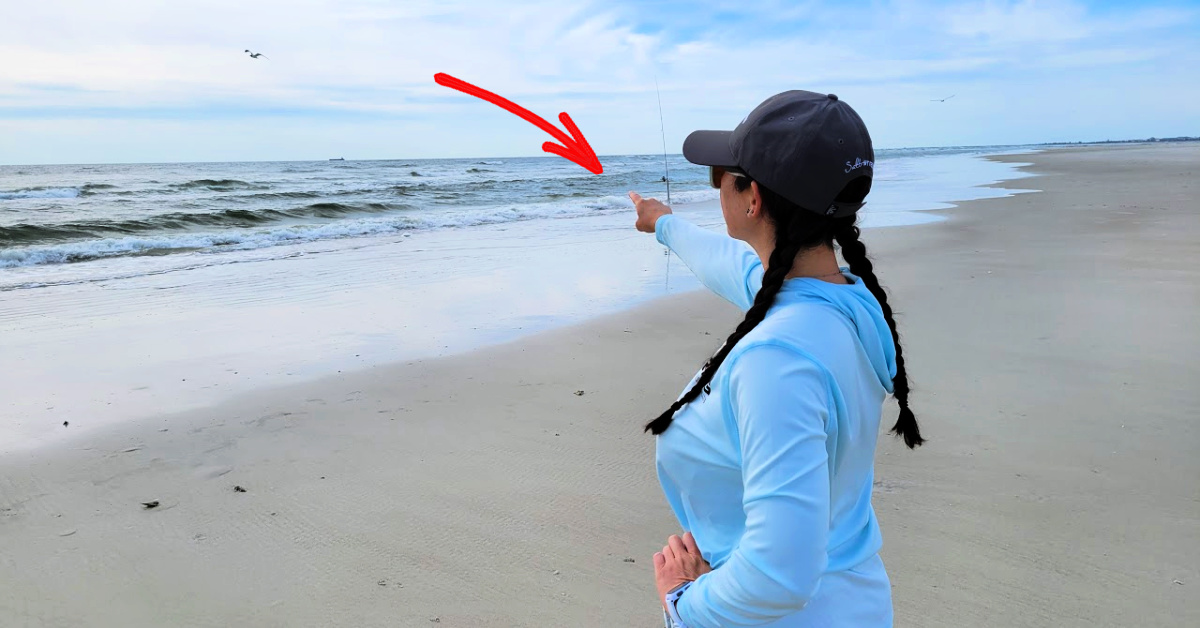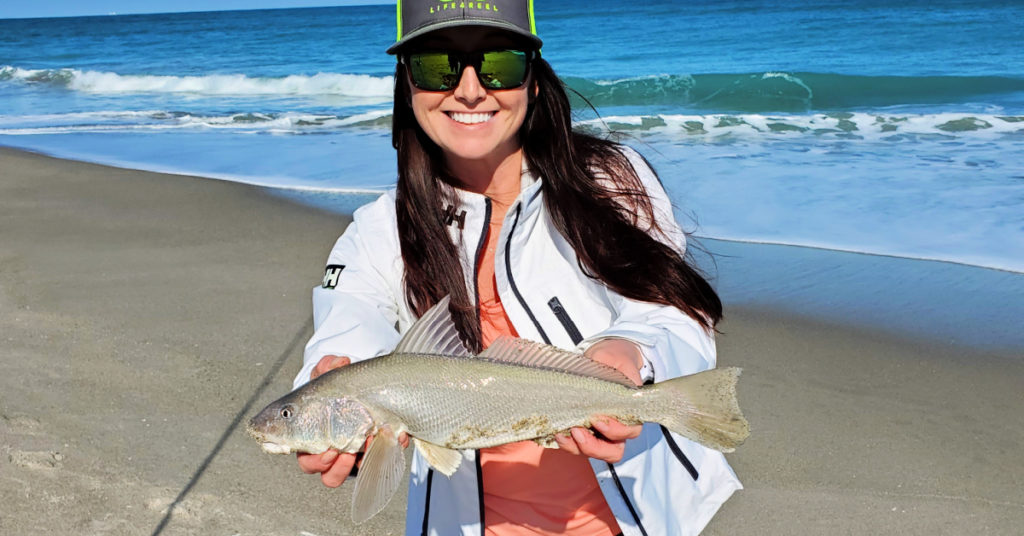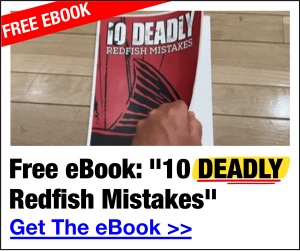How To Read The Beach When Surf Fishing (And Stop Getting Skunked)
- By: Courtney Woznek
- on
- Found In: Beach Fishing, Fishing Tips, Weekly Newsletter: 6-6-21

The most important thing you can learn about surf fishing is how to read the beach.
Knowing how to read the beach will allow you to find structure that provides food and protection for fish, so you can catch them.
In this video, you’ll learn:
- Why finding structure in the surf is crucial to finding fish
- What to look for at low tide
- How to identify different types of structure
- And more.
Check it out below!
Reading The Beach For Surf Fishing [VIDEO]

Scouting The Beach At Low Tide
Low tide provides you the opportunity to find different types of structure that would normally be covered with water at a higher tide.
As you scout the beach, make sure you are looking for:
- Points
- Holes
- Deep troughs
- Runouts
- High tide water line
Mentally marking the high tide water line will help you see how far you will need to cast to reach these pieces of structure.
You should also be observing the different baits that may be present like sandfleas, coquina clams, and baitfish.
This will allow you to match the hatch and determine what bait you should be using.
The Importance Of Beach Structure
Fish need two things.
To eat and to not be eaten.
Structure provides the food and protection that fish need to survive.
Anatomy Of A Beach & Wave Action
High-impact beaches offer a deeper shore break and since low-impact beaches gradually slope, they are often better to fish at a lower tide.
This is simply because you would have to cast really far to get to water that is deep enough to hold fish if you were at a low-impact beach at high tide.
Waves are energy moving through the water and when that energy meets structure, the wave crests and breaks.
When the wave crashes on the sandbar, it’s stirring up any bait that may be holding on the sandbar.
This creates a great feeding zone for fish cruising the beach.
Where To Cast To Catch More Fish
You’ll want to make sure that if you have multiple fishing rods they are casted out at different distances
Here are some spots that you want to have your baits at high tide:
- First deep trough
- Edge of the sandbar
- Middle of a runout
- Shore break (at a high impact beach)
- Just past the runout
- On the sandbar (if there’s enough water for fish to feed on the sandbar safely)
- Just past the sandbar
- Around a point on the beach
- Inside of a hole right off of the beach
At a lower tide, the same tactics apply but you’ll need to identify where the different types of structure are based on wave action and water movement.
If fish are in the area, they will be near structure for food and protection.
And while finding structure is a huge piece of the puzzle, you cannot be afraid to move to find where the fish are if you’re not getting a bite.
Conclusion

Whether you are using live baits or throwing lures, knowing how to read the beach should be a top priority if you want to be successful at surf fishing.
Scout the beach at low tide to find structure, identify where you need to cast, and this will give you the best chance at finding fish!
Do you have other tips for reading the beach?
Let me know down in the comments!
And if you know someone who wants to learn more about surf fishing, please TAG or SHARE this with them!
P.S. Want access to our best fishing spots and tips, plus discounts to our online tackle store? Click here to join us in the Insider Club!
Related articles:
Related categories:
STOP WASTING TIME ON THE WATER!
Do what the “SMART ANGLERS” are doing and join the Insider Club.
Here’s what you’ll receive today when you join:
- Weekly fishing reports and TRENDS revealing exactly where you should fish every trip
- Weekly “spot dissection” videos that walk you through all the best spots in your area
- Exclusive fishing tips from the PROS you can’t find anywhere else
- Everything you need to start catching fish more consistently (regardless if you fish out of a boat, kayak, or land).










This was really good. I have watched the Rich Troxler videos on YouTube and I know he means well but he just is too technical and not practical enough to actually show you what he’s talking about. Thank you for this.
Thanks Courtney. I have been weirdly oblivious to “fish highways” and make the mistake of casting as far as humanly possible. 🙂 Caught my first snook a couple of weeks ago and probably didn’t have more than 20′ of line out.
Great information. What rod and reel setups to you recommend?
Good job on the presentation – short to the point and easy to understand.
Great information!
Thanks Courtney. Great presentation with videos and chalk board drawing that shows exactly what you were describing. I have watched other fishing pros talk about reading the beach and their presentation was no where close to as good as yours, you hit it out of the park. Not only did you describe what to look for, you pointed it out with your fingers the exact location with live wave action footage. Then you had a white board drawing describing the video. I don’t know how anyone who watched your presentation does not not have a better understanding of what to look for on the beach. You constantly directed your information to our two senses and may have hit my third sense smell. when I thought I smelled salt air when I watched the video of the surf. waves and beach.
Thanks Courtney and tell Luke and Joe I want more fishing presentations from you.
Ed, thank you so much for your feedback! It helps to know we’re making things easy to understand and helping out the community. I appreciate you big time!!
Great video Ms. Courtney! I am grateful to be a Salt Strong Insider Member! I agree. The best beach reading video I’ve ever watched! Add complications, like current, incoming/outgoing tide, and wind. I realize you stated “best case scenario.” I’ve found maintaining a single rod on many beaches is a challenge.
Wow! That was awesome! Love your presentation, not one wasted sentence or word, right to the point. I have a tendency to ramble and this is will be a case study for me on how to get better.
I’ve never surf fished before but this video gave me enough confidence in going out and giving it a shot one day now I know what to look for. Thanks so much for this!
Thank you so much for the feedback, Pat!! You’ve definitely got to get out to the surf. It’s a blast!
Thanks Courtney!
Nice Explanation, concise and presented clearly with accompanying visual… I appreciate you 🙂
Thanks so much, Kevin! I’m happy you found it helpful!
Great concise info Courtney! Excellent presentation!
Appreciate the feedback, Peter!
Thank you so much for that break down. I’m glad you joined the team. I love surf fishing. I have a question about using google maps to asses an area. I’ve been looking at a spot Bob Graham beach to be specific and it looks like it’s low tide. You can see a change in color in the sand every so often. Are those guts created by rips?
Hi Bobby! Thanks so much for the support! I’m looking at the map now and yes, those look like a series of runouts. And depending on how deep those are, you’re looking at an excellent beach there at a higher tide!
Good deal. Thank you very much